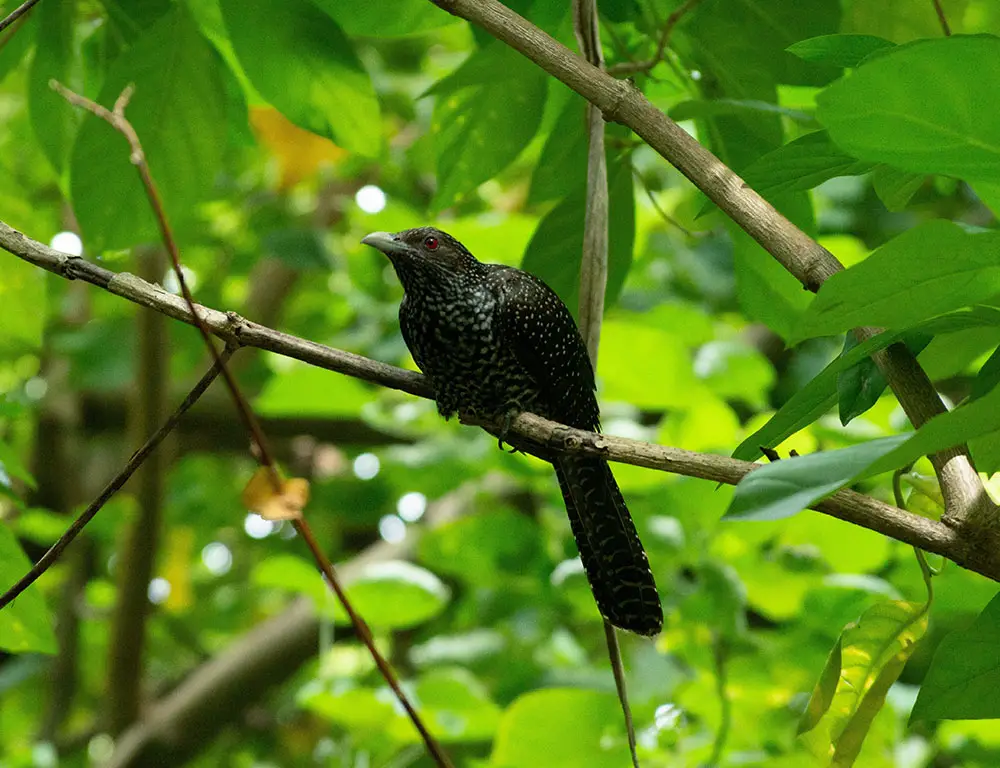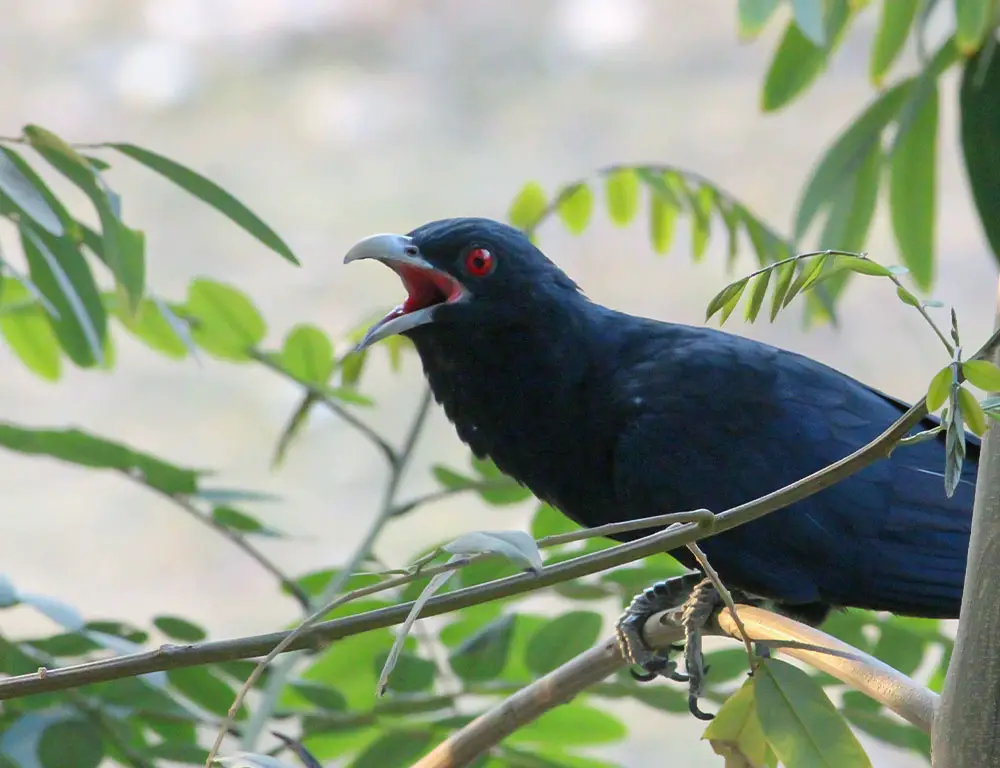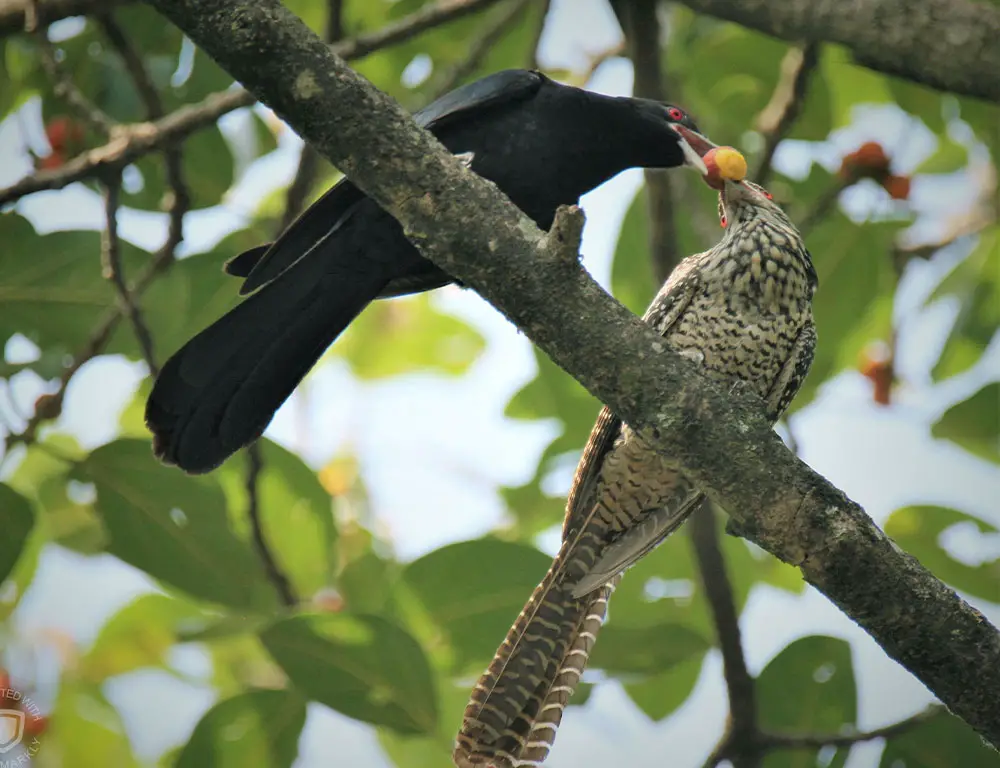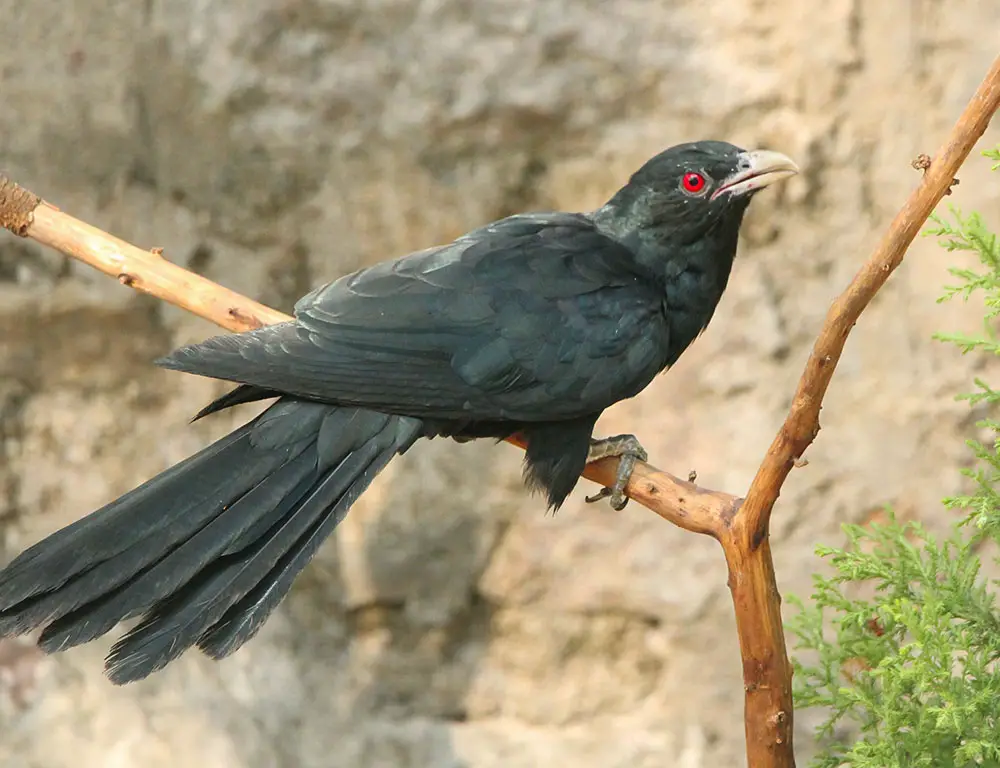In the verdant tapestry of Asian forests, one avian troubadour stands out with its haunting melodies and a mysterious presence – the Asian Koel (Eudynamys scolopaceus).
With its sleek plumage and captivating calls, this enigmatic bird has woven itself into the cultural and ecological fabric of the regions it inhabits.
From the dense jungles of Southeast Asia to the urban parks of India, the Asian Koel’s presence is felt as a symbol of wilderness and a harbinger of changing seasons.
In this exploration, we embark on a journey to unravel the secrets of the Asian Koel, delving into its fascinating biology, behavior, and cultural significance.
From its unique breeding habits to its role in local folklore and traditions, we seek to understand the intricate relationship between this feathered minstrel and the ecosystems it calls home. Join us as we venture into the world of the Asian Koel.

Key Identifying Characteristics of the Asian Koel
The Asian Koel is a distinctive bird known for its striking appearance and vocalizations. Here are the key identifying characteristics of the Asian Koel:
Size and Shape
The Asian Koel is a medium-sized bird, measuring approximately 39–46 centimeters (15–18 inches) in length, including its long tail. It has a relatively slender body with a rounded head and a distinctively curved bill.
Plumage
Male Asian Koels have glossy, iridescent plumage with predominantly dark blue-black coloring. They have bright crimson eyes and a vibrant red beak.
In contrast, females have brownish-gray plumage with white streaks and spots, providing effective camouflage for nesting.
Vocalizations

One of the most recognizable features of the Asian Koel is its distinctive call, which varies between males and females.
Male Asian Koels produce a loud, repetitive “koo-oo” or “ko-el” call, which can be heard throughout their territories during the breeding season. Females, on the other hand, emit a sharp, cackling “kik-kik-kik” call.
Tail
The Asian Koel has a long, graduated tail with distinct white tips on the outermost feathers. This feature is especially prominent in flight and helps to differentiate the bird from other species.
Sexual Dimorphism
Sexual dimorphism is pronounced in the Asian Koel, with males and females exhibiting striking differences in plumage. This dimorphism is known as sexual dichromatism.
Males display glossy black plumage, while females have a more subdued brownish-gray coloration.
Behavior
Asian Koels are often observed perched high in trees, where they emit their distinctive calls. They are primarily arboreal, meaning they spend most of their time in tree canopies, foraging for food and seeking shelter.
During breeding, males engage in territorial displays, often calling loudly to establish and defend their territories.
Habitat
Asian Koels inhabit many forested habitats, including tropical and subtropical forests, woodlands, gardens, and urban parks. They are adaptable birds and can also be found in agricultural areas and human-modified landscapes.
Range Map

The Asian Koel is distributed across a vast geographical range, from South to Southeast Asia and parts of East Asia. Its range includes countries such as India, Sri Lanka, Bangladesh, Myanmar, Thailand, Malaysia, Indonesia, and the Philippines.
Diet
Asian Koels are primarily frugivorous, meaning they feed on fruits and berries. They also consume other food, including insects, caterpillars, and small vertebrates. During the breeding season, they may also feed on eggs and nestlings of different bird species.
What Is the Taxonomic Level and Life History of the Asian Koel?
Delve into the taxonomy, life history, and ecological role of the captivating Asian Koel (Eudynamys scolopaceus).
Uncover the secrets of this charismatic bird species, from its taxonomic classification to its nesting habits and conservation status.
Taxonomy
| Taxonomy Level | Classification |
| Kingdom | Animalia |
| Phylum | Chordata |
| Class | Aves |
| Order | Cuculiformes |
| Family | Cuculidae |
| Genus | Eudynamys |
| Species | Eudynamys scolopaceus |
Food Habits

Asian Koels are primarily frugivorous, feeding on various fruits and berries. They also consume insects, caterpillars, and small vertebrates, especially during breeding.
Their diet varies depending on seasonal availability and habitat type, with a preference for ripe fruits and soft-bodied insects.
Nesting
| Nest Location | Description |
| Nest Placement | Chicks fledge around 10-14 days after hatching and become independent shortly afterward. |
| Nest Structure | They are usually built in the fork of a tree, shrub, or dense vegetation, often hidden from view. |
| Nest Building | Both male and female participate in nest construction, with the female primarily responsible for lining the nest. |
| Nesting Season | The female incubates the eggs while the male provides food. Both parents care for the hatchlings until they fledge. |
| Clutch Size | Typically nests during the breeding season which varies depending on geographic location and climate. |
| Incubation and Care | Chicks fledge around 10-14 days after hatching and become independent shortly afterward. |
| Fledging and Growth | Chicks fledge around 10-14 days after hatching and become independent shortly thereafter. |
Breeding
Asian Koels breed during the warmer months of the year, with breeding season timing varying across their range. Males establish territories and attract females through vocalizations and displays.
Once a pair forms, they select a suitable nesting site and begin constructing the nest. The female lays 1-3 eggs, which she incubates while the male provides food. Both parents care for the hatchlings until they fledge and become independent.
Conservation Status
The conservation status of the Asian Koel is currently of least concern according to the International Union for Conservation of Nature (IUCN).
However, like many bird species, Asian Koels face habitat loss, fragmentation, and urbanization threats.
Conservation efforts focused on habitat preservation, sustainable land management, and awareness-raising are crucial for ensuring the continued survival of this species.
7 Fun Facts About the Asian Koel

Embark on a journey to discover the charming quirks and fascinating facts about the Asian Koel, a bird of mystery and melody in the forests of Asia.
1. Cuckoo Clock Mimicry
Asian Koels are renowned for their uncanny ability to mimic the sound of a clock, earning them the nickname “Cuckoo Clock Birds.”
Their distinctive call, often heard during the breeding season, can resemble the ticking of a clock, fooling unsuspecting listeners.
2. Brood Parasitism
Like other cuckoo species, female Asian koels practice brood parasitism, laying their eggs in the nests of other bird species.
Host species, such as crows and drongos, unwittingly raise the koel chicks alongside their offspring, unaware of the imposters in their midst.
3. Gender-based Plumage
The plumage of male and female Asian Koels exhibits striking sexual dimorphism. Males boast glossy black plumage with vibrant red eyes and bills, while females sport a more subdued brownish-gray coloration with white streaks and spots, providing effective camouflage for nesting.
4. Influential Cultural Symbol
In many Asian cultures, the Asian Koel holds symbolic significance, often associated with love, longing, and the arrival of monsoon rains.
Its haunting call is believed to evoke feelings of romance and nostalgia, inspiring poets, musicians, and storytellers throughout the ages.
5. Arboreal Acrobats
Asian Koels are skilled climbers adept at maneuvering through dense foliage for food and shelter.
They often perch high in trees, emitting distinctive calls and engaging in territorial displays, showcasing their agility and adaptability in arboreal environments.
6. Seasonal Visitors
While Asian Koels are primarily residents in many parts of their range, some populations are known to undertake seasonal migrations in response to changing environmental conditions.
Depending on food availability and climatic patterns, these movements may vary in distance and duration.
7. Ecosystem Engineers
As frugivorous birds, Asian Koels play a vital role in seed dispersal, helping maintain forest ecosystems’ health and diversity.
By consuming fruits and berries and excreting seeds in new locations, they contribute to the regeneration of plant communities and the dispersal of genetic material across landscapes.
FAQs
Where is the Asian Koel found?
The Asian Koel (Eudynamys scolopaceus) is native to many Asian habitats, including tropical and subtropical forests, woodlands, gardens, and urban parks.
It is commonly found in India, Sri Lanka, Bangladesh, Myanmar, Thailand, Malaysia, Indonesia, and the Philippines.
What does the Asian Koel eat?
Asian Koels are primarily frugivorous, meaning they feed mainly on fruits and berries. However, they also consume other food items, including insects, caterpillars, and small vertebrates.
How does the Asian Koel reproduce?
Asian Koels breed during the warmer months of the year, with breeding season timing varying across their range.
Males establish territories and attract females through vocalizations and displays. Once a pair forms, they select a suitable nesting site and begin constructing the nest.
Is the Asian Koel a migratory bird?
While some populations of Asian Koels may undertake seasonal movements in response to changing environmental conditions, they are primarily resident birds in many parts of their range.
What is the conservation status of the Asian Koel?
The conservation status of the Asian Koel is currently of least concern according to the International Union for Conservation of Nature (IUCN).
However, like many bird species, Asian Koels face habitat loss, fragmentation, and urbanization threats.
Conclusion
In the verdant realms of Asian forests, the Asian Koel is a symbol of mystery and harmony. Its haunting melodies and sleek plumage captivate the imagination, while its presence is a testament to the interconnectedness of ecosystems and cultures.
Through our exploration, we have uncovered the multifaceted nature of this enigmatic bird – from its unique breeding habits to its profound influence on local folklore and traditions.
As stewards of the natural world, we are responsible for safeguarding the habitats and ecosystems upon which the Asian Koel and countless other species depend.
By embracing the lessons of coexistence and reverence for biodiversity embodied by the Asian Koel, we can forge a more harmonious relationship with the natural world.
Let us continue to cherish and protect the Asian Koel, ensuring its timeless melodies continue to grace the forests for generations.